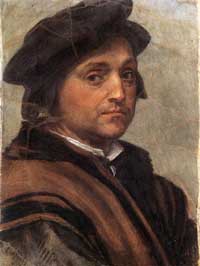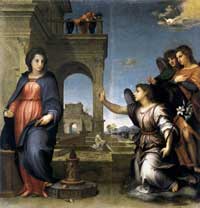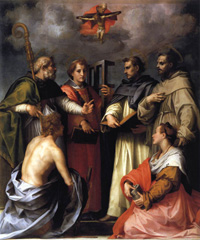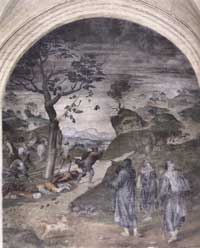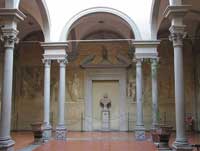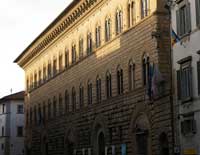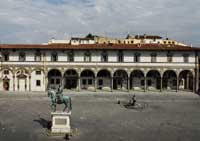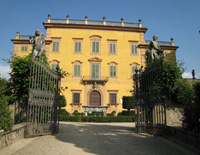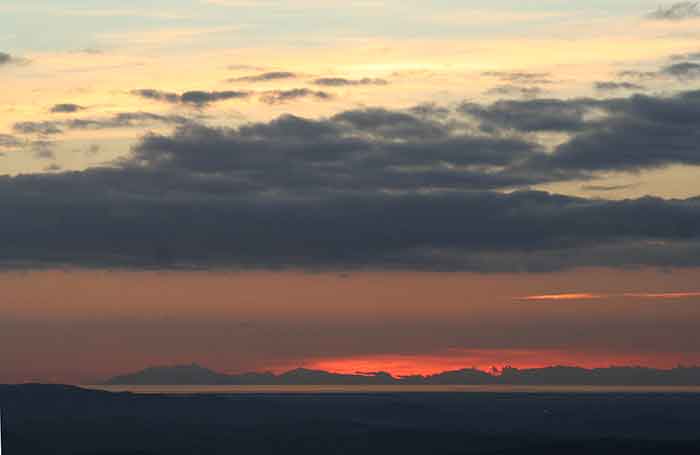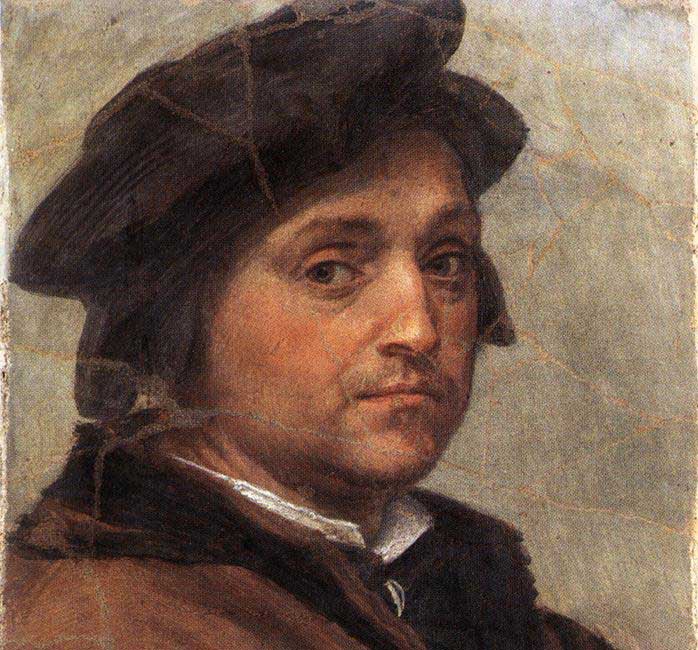 |
|
Andrea del Sarto, Self-portrait, oil on wood, 47 x 34 cm, Galleria degli Uffizi, Florence
|
|
Andrea del Sarto |
| The Italian painter Andrea del Sarto (1486-1530) was one of the most important painters of the High Renaissance. His highly expressive use of color is unsurpassed in Florentine painting. Though highly regarded during his lifetime as artisat senza errori ("without errors"), his renown was eclipsed after his untimely death by that of his contemporaries, Leonardo da Vinci, Michelangelo, and Raphael. Andrea was born in Florence on July 16, 1486. He was the son of Agnolo di Francesco, a tailor (Italian, sarto), hence the name Andrea del Sarto. According to Vasari, who was a pupil of Andrea, he was trained with a goldsmith from the age of 7. An earlier source identifies Andrea's master, quite convincingly, as Rafaellino del Garbo, a highly competent and successful painter of the late 15th century. About the age of 20 Andrea set up an independent shop with Franciabigio, although he did not matriculate in the painters' guild until Dec. 11, 1508. Early Period Middle Period Late Period |
||
| Comparatively little is known of the later part of Andrea's life, although his presence is frequently documented in Florence and his paintings offer no real evidence of any extensive travels. In 1520 he purchased a site on the Via della Crocetta and built a house. In 1524 Andrea took his family to the Mugello to avoid the plague. There he painted the Pietà (Florence), which, though more restrained in its color and emotion than the earlier Pietà (ca. 1520; Vienna), forms the point of departure for the deliberately appealing beauty of the late works. The increasing idealization and the sometimes arbitrary but acutely expressive color of paintings such as the Quattro Santi (1528; Florence) and St. Agnes (1527-1528; Pisa Cathedral) provided a rich source of inspiration for the young generation of mannerist painters. Yet the powerful devotional feeling in these works is evident from the exaggerated praise that Andrea received from writers of the Counter Reformation. He died of the plague on Sept. 29, 1530, and was buried by the religious confraternity of the Scalzo in the Church of SS. Annunziata. His Character |
||
|
||
Journey of the Magi |
||
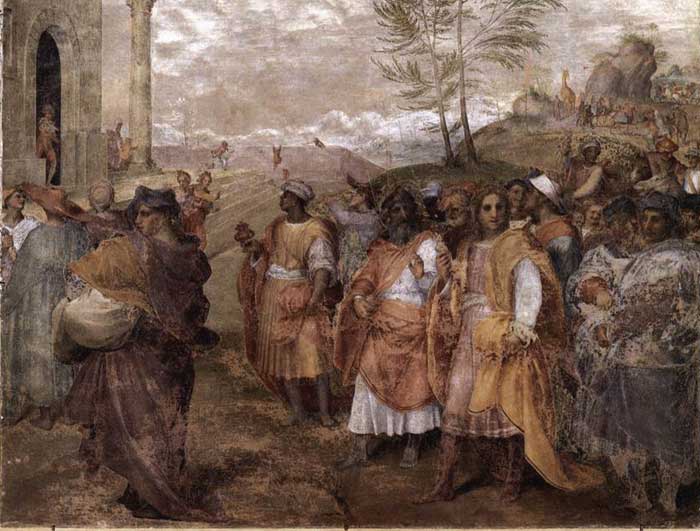 |
||
Andrea del Sarto, Journey of the Magi, 1511, fresco, 360 x 305 cm, Santissima Annunziata, Florence
|
||
| Andrea del Sarto's impressively fluent and richly lyrical style is manifested first in his series of five mural paintings depicting scenes from the story of the spiritual founder of the Servite Order, Filippo Benizzi. They were created for the atrium of the important pilgrimage church of Santissima Annunziata in Florence from 1509 onwards. They were followed by two more frescoes with biblical subjects on the opposite side of the space, the last of which, the Birth of the Virgin is dated 1514.
The Journey of the Magi represents an almost unprecedented subject showing the three Magi arriving in train at Herod's palace displaying portraits of contemporaries. |
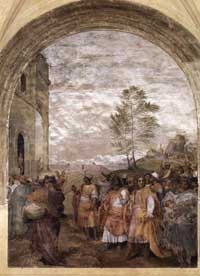 Journey of the Magi, Santissima Annunziata, Florence Journey of the Magi, Santissima Annunziata, Florence |
|
|
||
Triumph of Caesar |
||
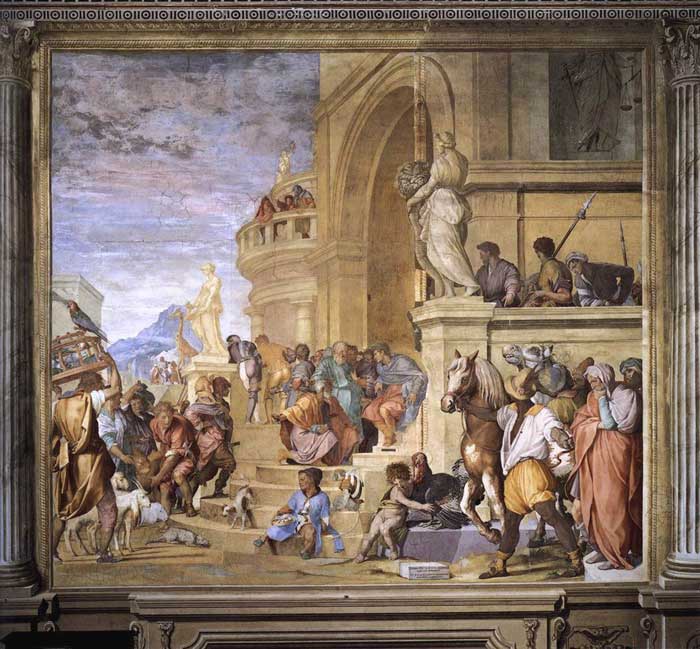 |
||
Andrea del Sarto, Triumph of Caesar, fresco in Villa Medicea di Poggio a Caiano |
||
| This fresco, no less than the other frescoes in the main hall of the Villa Medici at Poggio a Caiano, is brilliantly sensitive to its setting, which accounts for the angle and height of viewing and the open lighting. The content of the painting alludes to events of purely local import, such as the return of Cosimo de' Medici from exile in 1434 or the donation of the Sultan of Egypt to the Florentines in 1487 of a menagerie of exotic animals. In 1582 Alessandro Allori added several details to the right-hand part of the picture. |
||
|
||
Paintings in the Galleria Palatina (Palazzo Pitti), Florence |
||
The Annunciation (1512-13) Andrea painted The Annunciation for the convent of San Gallo which was subsequently destroyed in the siege of Florence (1529). The panel was then transported by the Augustinian Brothers to their new seat, San Jacopo tra i Fossi, whence in 1626 it passed into the possession of the Grand Duchess Maria Maddalena who transferred it to the chapel then being built in Palazzo Pitti. It is an early work of Andrea done when Pontormo was in his workshop. |
||
Punishment of the Gamblers |
||
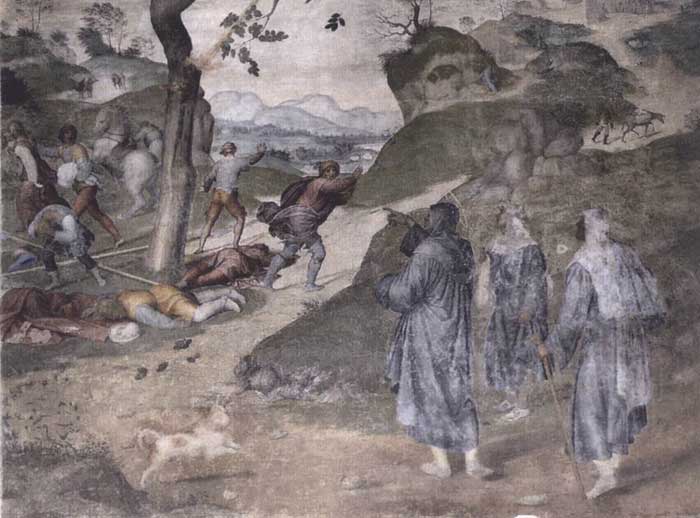 |
||
Andrea del Sarto, Punishment of the Gamblers, fresco, 360 x 300 cm, Santissima Annunziata (Firenze) |
||
| Andrea del Sarto's early work echoes of Leonardo, Raphael, and Fra Bartolomeo can be observed, but it is the naturalism of Andrea"'s teacher Piero di Cosimo - in whose shop he remained from about 1498 to 1508 - that is most evident in his frescoes of the life of St Philip Benizzi. There are located in the atrium of the Santissima Annunziata, near Baldovinetti's light-filled Nativity. Throughout the series, Andrea retained the sense of outdoor light and atmosphere seen in Baldovinetti's fresco; this was suggested by the site itself, which was filled with sunlight. The fantastic landscape masses, jutting rocks, and trees in the scene in which the saint punishes gamblers derive from Piero di Cosimo. | ||
Andrea del Sarto's impressively fluent and richly lyrical style is manifested first in his series of five mural paintings depicting scenes from the story of the spiritual founder of the Servite Order, Filippo Benizzi. They were created for the atrium of the important pilgrimage church of Santissima Annunziata in Florence from 1509 onwards. They were followed by two more frescoes with biblical subjects on the opposite side of the space, the last of which, the Birth of the Virgin is dated 1514. The Journey of the Magi represents an almost unprecedented subject showing the three Magi arriving in train at Herod's palace displaying portraits of contemporaries |
Journey of the Magi 1511 Fresco, 360 x 305 cm Santissima Annunziata, Florence |
|
Baptism of the People |
||
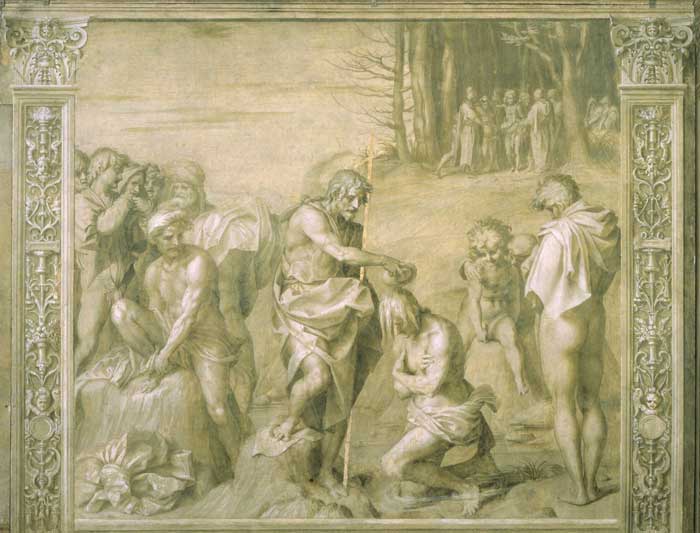 |
||
Andrea del Sarto, Baptism of the People, 1515-17, fresco, Chiostro dello Scalzo, Florence |
||
| The Cloister of the Scalzo was part of the building designed for the Confraternity of St. John the Baptist, founded in 1376 and called "dello Scalzo" because the cross-bearers in the Confraternity's processions was barefooted. The Brotherhood was suppressed in 1785 by Pietro Leopoldo of Lorraine, who sold off their property with the exception of the cloister containing sixteen frescoes in chiaroscuro, showing episodes of the Life of St. John the Baptist, painted by Andrea Del Sarto (1486-1530) (only two of the scenes were painted by Franciabigio (1482-1525), while Andrea was in Paris in 1518). Painted between 1514 and 1524, the frescoes represent an extraordinary example of stylistic and technical perfection in the art of a Master, who played an important role in the complex artistic events of Florence at the beginning of the 16th century. He played also a role now recognized as fundamental to the developement of Mannerism. Art in Tuscany | Andrea del Sarto | Chiostro dello Scalzo |
||
Andrea del Sarto, The Last Supper 1520-25 Fresco, 525 x 871 cm Convent of San Salvi, Florence |
||
| Leonardo's Last Supper was copied and adapted in several refectories, particularly in Lombardy. Andrea del Sarto's fresco in the former refectory of the Vallombrosan monastery of San Salvi in Florence also testifies to knowledge of Leonardo's fresco. The impact and movement of Leonardo's figural composition have been moderated. Andrea's narrative is more human and touching; it reduces the heroic drama of gestures and figures. It shows a nearly enclosed hall, in whose articulations the row of apostles is embedded. The community at table with Christ is given a formal pendant in the form of a window loggia. A charming, anecdotal subsidiary motif results: two servants are conversing in the central opening. Above the entire scene is an arch with medallions displaying the Trinity and the saints of the order. | ||
|
||
Andrea del Sarto, Lamentation of Christ c. 1520 Oil on wood, 99 x 120 cm Kunsthistorisches Museum, Vienna |
||
|
||
Andrea del Sarto, St John the Baptist c. 1523 Oil on wood, 94 x 68 cm Galleria Palatina (Palazzo Pitti), Florence |
||
| St John the Baptist is a celebrated picture. Although actually disfigured by bad restorations in old times which have changed the background and diminished the splendor and especially the interrelation of colors, there still remains the frank, original and lively conception of this youthful figure. |
||
|
||
Andrea del Sarto, Madonna del sacco (Madonna with the Sack) 1525 Fresco, 191 x 403 cm Santissima Annunziata, Florence |
||
| Returning to the quarter of the SS. Annunziata after the plague, in 1525 Andrea painted one of his most celebrated works in the great cloister, known as the Chiostro dei morti. It is considered to be the ultimate masterpiece of Andrea del Sarto's classicism. The solemn equilibrium, the quality of repose and grandeur, the supreme elegance of this scene illustrating the Rest during the Flight into Egypt, classically framed by the high step and the two pilasters, but laid out in an unconventional manner, make this fresco one of the loftiest achievements of the late phase of Andrea's art. The influence of Michelangelo (a number of figures on the vault of the Sistine Chapel are mentioned as prototypes) are elements in a language which is totally personal, powerful and mature. | ||
|
||
Andrea del Sarto, Virgin and Child in Glory with Six Saints c. 1528 Oil on wood, 209 x 176 cn Galleria Palatina (Palazzo Pitti), Florence |
||
| Vasari mentions this panel as having been painted for Becuccio, a glassmaker, from Gambassi, and adds that it had a predella with the lively portraits of Becuccio and his wife. (The two little tondi with the portraits are now in Chicago.) The represented saints are Lawrence, Onophrius, John the Baptist, Mary Magdalen, Sebastian and Roch. he panel was placed to an altar dedicated to the hermit saints Lawrence and Onophrius in the female monastery of the Eremite Benedictines, the Pieve di Sta Maria a Chianni a Gambassi.
The design is symmetrical, forming a three-dimensional pyramid with the saints circled round the raised divine centre, with those in front kneeling down to admit the viewer's eye past them to the Virgin located further back in the space. The painting well represents the late style of Andrea. |
||
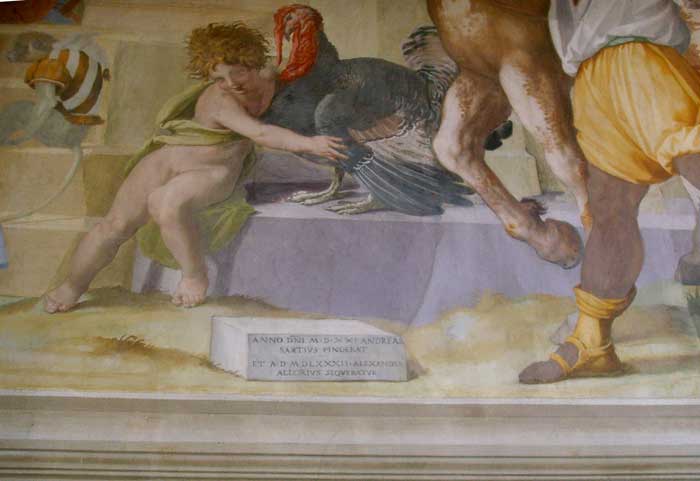 |
||
Fresco by Alessandro Allori and Andrea del Sarto (the signature) in Villa medicea di Poggio a Caiano, inside sala di Leone X |
||
|
||
|
||
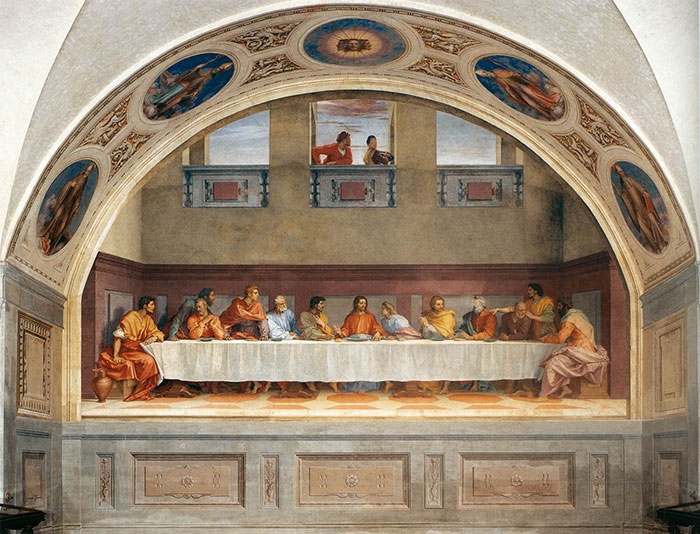 |
||
Andrea del Sarto, The Last Supper, 1520-25, fresco, 525 x 871 cm, Convent of San Salvi, Florence
|
||
"In the old refectory of the Vallombrosan Abbey on the outskirts of Florence, Andrea del Sarto painted the life-like Last Supper, his most spectacular masterpiece and one of the most beautiful paintings in the world. The Last Supper was begun in 1519 and was finished between 1526 and 1527 and he painted it in so good a style that his work was held to be, as it certainly is, the most smooth, the most vivacious in colouring and drawing that he ever did, or rather that anyone could do. For apart from all the rest, he gave such infinite grace, grandeur, and majesty to all the figures that I do not know how to praise his Last Supper without saying too little, it being so fine that whoever sees it is stupefied. Art in Tuscany | Last supper frescoes in Florence |
||
|
||
|
||
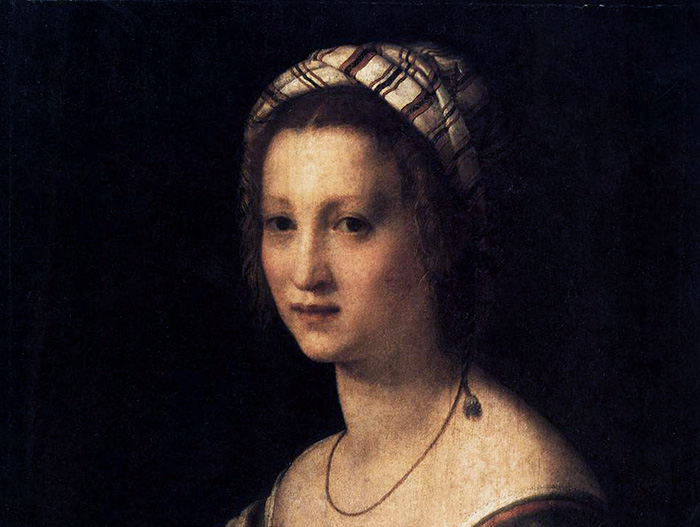 |
||
Andrea del Sarto, Portrait of Lucrezia di Baccio del Fede, wife of the painter,( (detail) 1513-1514, oil on wood, 73x56 cm Madrid, Museo Del Prado
|
||
Art in Tuscany | Portrait of Lucrezia de Baccio Del Fede |
||
|
||||
Palazzo Medici Riccardi, Florence |
Piazza della Santissima Annunziata in Florence |
Florence, Duomo |
||
Museo Cenacolo di Andrea del Sarto Firenze | Il museo del Cenacolo di Andrea del Sarto occupa un antico convento dei Vallombrosani intitolato a San Salvi. Il nome deriva dal Cenacolo, un grande affresco raffigurante l' Ultima Cena, situato nel refettorio, opera di Andrea del Sarto e considerato uno dei capolavori della pittura del Rinascimento. |
||||
|
||||
Podere Santa Pia |
Podere Santa Pia, giardino |
The Hospital of the Innocents, façade by Filippo Brunelleschi |
||
 |
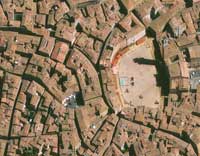 |
|||
Villa La Pietra, near Florence |
Panorama Sant’Angelo in Colle, Montalcino | Siena, Piazza del Campo |
||
|
||||
| This idyllic rural retreat with wooded valleys below and stunning views to to the Tyrrhenian coast and Monte Christo and even Corsica | ||||
This article incorporates material from the Wikipedia article Andrea del Sarto published under the GNU Free Documentation License. |
||||

